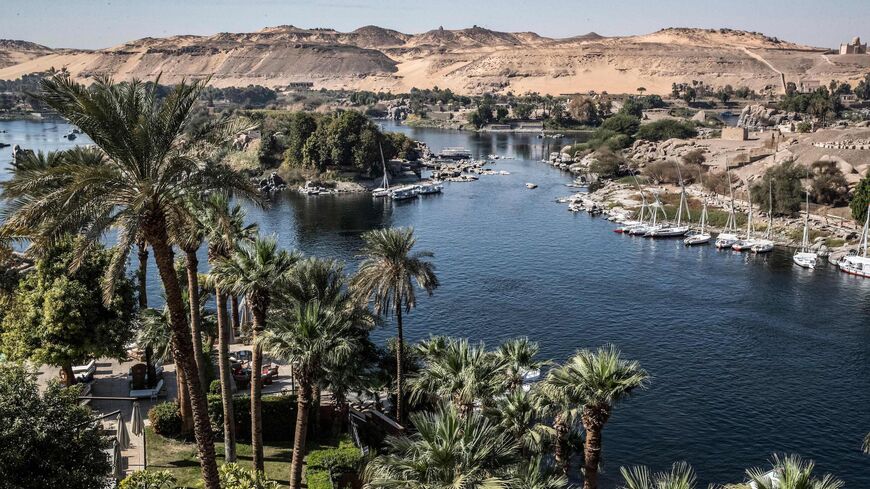20 ancient mummies discovered in Aswan tomb

An Egyptian-Italian archaeological mission has discovered 20 well-preserved 2,000-year-old mummies in the necropolis around the mausoleum of Aga Khan in West Aswan, Egypt. The mummies were found in a large and previously unknown tomb beneath a place of worship dedicated to the Ancient Egyptian god Khnum.
The whole complex, well preserved despite showing traces of fire, consists of two structures. The above-ground portion was the first structure to be found in this ancient cemetery, which extends over a vast area on the west bank of the Nile's First Cataract. The second, the tomb, was carved into the rock beneath. The team is now working out their connection to each other and to the rest of the necropolis.
The discovery came as a surprise to the mission. The team decided to focus last year on the above-ground structure, which was originally believed to be a tomb. During the excavation, they found evidence of a worship site including fragments of pottery, offering tables, fruit remnants, slabs inscribed in hieroglyphs and most importantly, a huge trove of animal bones, mainly rams. The head of Khnum, one of the earliest-known Egyptian deities, is usually depicted with a ram's head.
Patrizia Piacentini is a professor of egyptology at the University of Milan, Italy, and co-head of the mission. She told Al-Monitor, "We thought it was the court of a tomb, and we started to excavate there because it was different from the tombs we had found before. Clearly there were offerings; this was a sort of an offering place," she added.
While working on the upper structure, the team noticed that part of the floor was broken. They dug into that area and found stairs leading to the underground tomb. The stairs were flanked by sculpted blocks and covered by a mud-brick vault, and the tomb's entrance was sealed by stone slabs and blocks. At the door, the team found the remains of a large offering vase still containing the remains of a fig species.
Inside they discovered a large family tomb dating to the Greco-Roman period. Despite having been looted in ancient times, it still contained 20 mummies in a very good state of preservation and other significant finds. The entrance to the tomb led to a hall where the team found a terra cotta sarcophagus containing the mummy of a child and cartonnage Piacentini called "astonishing."
Four funerary chambers, deeply carved into the rock, opened onto the hall. "We found 20 mummies intact, and 10 more individuals that were also originally mummies but [whose] bodies were dismembered because thieves in antiquity went inside the tombs and broke the mummies," Piacentini said. Some mummies were of old persons with evident arthrosis, and others women and young children, including a newborn baby.
The mummy of a man was also found in the upper structure. Beside him lay a copper necklace with a plaquette engraved with his name in Greek: Nikostratos. Archaeologists believe that he was originally placed in the tomb but taken out by ancient looters. Because his was the only name found at the site, the team decided to name the tomb after him.
"We are still studying to understand if the offering place was only for that tomb, which I don't think is the case, or if it was an offering place for a group of tombs," Piacentini said. "In 2022 we decided to excavate around the present tomb and cultic place to see how the other tombs around are tied to them."
The team is also trying to uncover the origin of a mysterious fire that burned the upper structure and part of the tomb underneath.
"There are two possibilities," Piacentini noted. "That during the offerings, when they burned animals, a fire started and went down to the tomb," she said. "Or that — and perhaps this is more likely — the ancient thieves who went into the tombs to look for treasures and precious things had torches in their hands and the fire started in the tomb."
The joint Egyptian-Italian mission has been working in the necropolis surrounding the mausoleum of the Aga Khan since 2019. So far, they have located more than 300 tombs dating from the sixth century BC to the fourth century AD, although the total number is believed to be much higher in the largely unexplored area of around 100,000 square meters.
"In Aswan we have necropolises of previous periods," Piacentini said. "We knew before our excavations that there was a town of Persian, Greek and Roman times — the Late Pharaonic period [to] the Graeco-Roman period — but we didn't know the place where these people were buried."
The necropolis, she said, "covers one millennium of history. And the number of tombs is very high. We will never excavate everything; it would take centuries. But if we excavate well, a good sample of tombs, I think we can understand better the way in which people were buried at that time and, what is more important, the way they lived."
-- Sent from my Linux system.
No comments:
Post a Comment